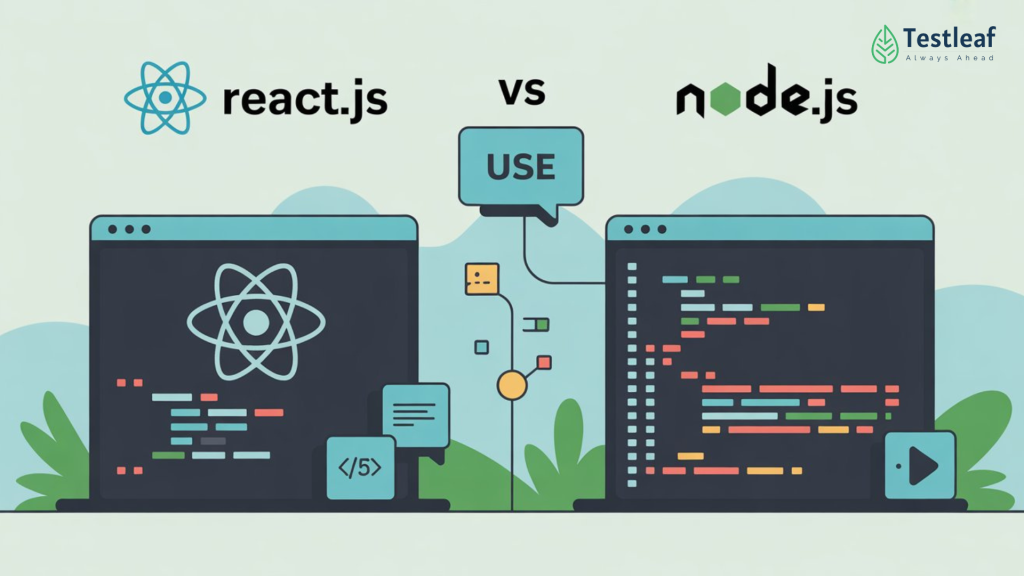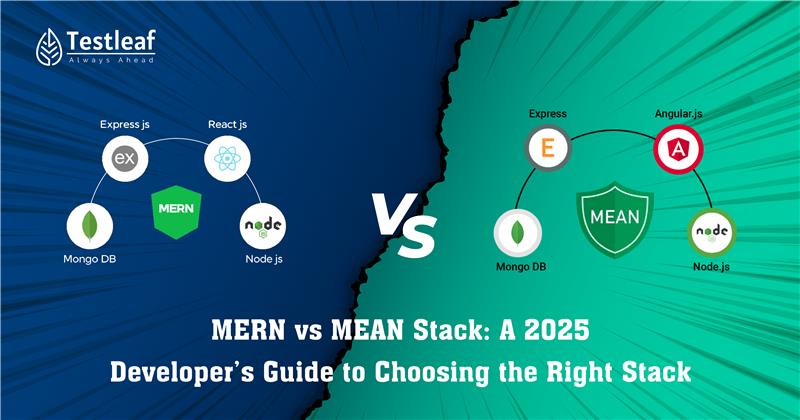If you’re aiming to build modern web applications—and especially if you’re considering a course for full stack developer or exploring full stack developer courses online—you’ll inevitably run into two powerhouse technologies: Node.js and React.js. Deciding which to use or how to combine them can make a huge difference in performance, developer experience, and the success of your project.
In this post, we’ll explore what each tool is, compare their strengths and limitations, and help you decide which one fits best depending on your project type. We’ll also look at how both can work together and what you should want to learn if you’re pursuing full stack developer courses online.
What Are Node.js and React.js?
– Node.js
Node.js is a runtime environment that allows JavaScript to run on the server. It’s often used to build back-end applications—APIs, microservices, real-time systems—and works with server-side logic, database interactions, and more.
– React.js
React.js is a front-end library (often called a framework) developed by Facebook to build interactive user interfaces. It helps in developing UI components, managing state, and rendering changes efficiently in the browser.
So in short: Node.js serves your application’s logic, data, and backend; React.js handles how the app looks and behaves in the browser.
Popular Articles: selenium interview questions
Key Areas of Comparison
| Aspect | Node.js | React.js |
| Primary Purpose | Server-side logic: database, APIs, authentication, routing, etc. | Client-side UI: rendering views, user interactions, state, components. |
| Performance | Very good with I/O-bound, real-time, event-driven operations. Excellent for chat apps, streaming, microservices. | Excellent for rendering speed, responsive UI; Virtual DOM helps minimize direct heavy DOM operations. |
| Learning Curve | Easier for those already familiar with JS—focuses on server-side JS. Asynchronous programming is something to master. | Requires understanding of JavaScript fundamentals plus concepts like JSX, component lifecycle, hooks or state management. Slightly steeper for absolute beginners. |
| Community Support | Huge ecosystem via npm; tons of libraries and tools. Many developers, many packages. | Also very strong—React has large adoption, many UI component libraries, rich ecosystem of tools. |
| Scalability & Architecture | Excellent for building microservices and scalable backend systems. Node.js works nicely with containerization (Docker, Kubernetes). | Scales well in front-end apps, especially in Single Page Applications (SPAs). For large front-ends, code-organization, state management, and performance optimizations matter. |
| Use Cases | REST APIs, backend for mobile/web apps, real-time systems (web sockets), microservices, serverless functions. | Front-end dashboards, interactive user interfaces, SPAs, mobile app front-ends (React Native). |
Advantages & Limitations
# React.js — What It Does Well
Advantages:
– Renders fast updates by using Virtual DOM.
– Encourages modular, component-based architecture, which improves reusability and maintainability.
– Works well with modern front-end tooling (webpack, Babel, ESLint, etc.).
– Supports server-side rendering (SSR) through tools like Next.js, which aids SEO.
– Widely covered in full stack developer courses online.
Limitations:
– Only handles the UI layer; you’ll still need something for backend logic.
– Concepts like hooks, state, lifecycle can get confusing for newcomers.
– Frequent updates can lead to breaking changes or documentation lag.
# Node.js — What It Excels At
Advantages:
– Non-blocking I/O, event-driven architecture gives great performance for many simultaneous connections.
– Possible to use JavaScript across both front-end and back-end in a full stack development setup.
– A large library ecosystem via npm means almost anything you need has already been solved before.
– Often easier and faster to get a basic server up and running.
Limitations:
– Asynchronous code can become hard to follow if not organized well.
– Because it’s server-side JS, tasks like CPU-bound work (heavy computations) can suffer compared to languages designed for multithreading.
– API changes in npm packages or core modules can occasionally break things—version management matters.
Recommended for You: automation testing interview questions
Combining Node.js + React.js — Ideal Full Stack Setup
Often the smartest path is using both: React.js for front-end, Node.js for back-end. This gives you:
– Unified language across client and server—easier context switching, sharing code/utils.
– Better performance: React for client-side rendering or parts of it, Node handles API, data handling, storage, business logic.
– More robust product: front-end can deliver smooth user experience; backend handles data, security, persistence.
Many course for full stack developer curricula emphasize this combo. You’ll likely learn how React calls APIs developed in Node.js, manage state in React, set up routes and security in Node, and build together in real projects.
Which One to Choose Based on Your Project & Goals
Here are scenarios and recommendations:
| Scenario | Use Node.js | Use React.js | Use Both |
| You’re building just an API / backend service (e.g., for mobile app) | ✅ | ❌ | — |
| You are designing a front-facing web dashboard or user interface | ❌ | ✅ | — |
| You need full stack functionality (front + back + database) | — | — | ✅ |
| Goal is to optimize SEO and initial load time | — | ✅ (with SSR or static rendering) | ✅ |
| Small product, fast MVP | Use React + static backend or serverless with Node.js | — | React front-end + Node for backend minimal logic |
What Full Stack Developer Courses Online Typically Teach
If you’re looking at a course for full stack developer, either as part of self-learning or a structured online program, these are topics you’ll likely cover:
1. Front-End Basics: HTML, CSS, JavaScript, web fundamentals.
2. React.js: Components, state, props, hooks, routing, performance optimization.
3. Back-End Basics: Node.js concepts, Express.js (or similar), RESTful APIs, authentication.
4. Database: SQL / NoSQL (MongoDB, PostgreSQL, etc.).
5. DevOps / Deployment: Hosting, server setup, possibly Docker, CI/CD pipelines.
6. Project Work: Building real-world applications combining React front-end + Node.js backend.
Final Thoughts
If you’re making a decision:
– Choose React.js if your main concern is building a responsive, rich user interface.
– Choose Node.js if building backend services, real-time features, or dealing with servers and data.
– To maximize flexibility and job-readiness, aim to master both. A course for full stack developer that teaches full stack developer courses online with Node.js + React.js will give you a strong foundation for modern web development.
Together, React + Node make a formidable stack. Paired with a good learning path, hands-on projects, and practice, you’ll be well-prepared to launch great web applications and to position yourself strongly in the tech job market.
FAQs
What is the difference between Node.js and React.js?
Node.js is a runtime for backend development, while React.js is a front-end library for building user interfaces.
Can I use Node.js and React.js together?
Yes. Node.js powers backend APIs and data handling, while React.js builds the frontend UI. Together, they form a strong full stack.
Which is better—Node.js or React.js?
Neither is “better”—it depends on your project. Use Node.js for backend services and React.js for UI. For full stack apps, use both.
Is Node.js frontend or backend?
Node.js is backend—it runs server-side logic, APIs, and database operations.
Is React.js frontend or backend?
React.js is frontend—it builds UI components, manages state, and renders browser interactions.
Which should beginners learn first—React or Node?
Beginners often start with React for UI development, then learn Node.js to handle backend and APIs, making them full stack ready.
We Also Provide Training In:
- Advanced Selenium Training
- Playwright Training
- Gen AI Training
- AWS Training
- REST API Training
- Full Stack Training
- Appium Training
- DevOps Training
- JMeter Performance Training
Author’s Bio:

As a Senior SDET with 8+ years in testing and development, I build scalable automation platforms ensuring quality at speed. Passionate about mentoring and innovation, I equip teams with real-time solutions and high-impact frameworks, driving excellence through continuous learning. Let’s shape the future of quality engineering together.
Dilipkumar Rajendran
Senior SDET | Playwright & Selenium Expert





